This article was co-authored by Chris M. Matsko, MD. Dr. Chris M. Matsko is a retired physician based in Pittsburgh, Pennsylvania. With over 25 years of medical research experience, Dr. Matsko was awarded the Pittsburgh Cornell University Leadership Award for Excellence. He holds a BS in Nutritional Science from Cornell University and an MD from the Temple University School of Medicine in 2007. Dr. Matsko earned a Research Writing Certification from the American Medical Writers Association (AMWA) in 2016 and a Medical Writing & Editing Certification from the University of Chicago in 2017.
This article has been viewed 395,010 times.
Oral cancers of the mouth and throat account for about 2% of all cancers diagnosed each year in the U.S.[1] Early detection and timely treatment of oral cancers is important because it greatly increases the chances of survival. For example, the five-year survival rate for those with oral cancer that hasn't spread is 83%, whereas it's only 32% once the cancer spreads to other parts of the body.[2] Although your doctor and dentist are trained to detect oral cancers, recognizing the signs yourself may facilitate an earlier diagnosis and more timely treatment. The more aware you are, the better
Steps
Looking for Physical Signs
-
1Examine your mouth regularly. Most cancers of the mouth and throat cause some identifiable signs or symptoms during their early stages, but not all do. In some cases, cancers don't cause symptoms until they’ve reached an advanced stage. Regardless, doctors and dentists recommend that in addition to regular checkups, you should carefully look at your mouth in a mirror at least once a month to check for any abnormal signs.[3]
- Oral cancers can grow virtually anywhere in your mouth and throat, including the lips, gums, tongue, hard palate, soft palate, tonsils, and insides of the cheeks.[4] Teeth are the only parts that can't develop cancer.
- Consider buying, or borrowing from your dentist, a small dental mirror in order to help you examine your mouth more thoroughly.
- Brush your teeth and floss before examining your mouth. If your gums normally bleed after brushing or flossing, rinse with some warm salt water and wait a few minutes before examining.
-
2Look for small white sores. Check all around your mouth for small white sores or lesions, which are called leukoplakia by doctors. Leukoplakia are common precursors to oral cancers, but they are often misdiagnosed as canker sores or other small ulcers caused by abrasions or minor trauma.[5] Leukoplakia can also be mistaken for bacterial infections of the gums and tonsils, as well as Candida yeast overgrowth in the mouth (called thrush).
- Although canker sores and other ulcers are usually very painful, leukoplakia aren't typically, unless they're in advanced stages.
- Cankers are most common on the inner lips, cheeks and sides of the tongue, whereas leukoplakia can be anywhere in the mouth.
- With good hygiene, canker sores and other small abrasions and cuts usually heal within a week or so. In contrast, leukoplakia don't go away and often become larger and more painful with time.
- In general, any white sore or lesion in your mouth that lasts longer than 2 weeks should be evaluated by a medical professional.
Advertisement -
3Watch for red sores or patches. While checking the inside of your mouth and back of your throat, watch out for small red sores or patches. Red sores (lesions) are called erythroplakia by doctors, and although less common than leukoplakia in the mouth, they have a much greater potential for becoming cancerous.[6] Erythroplakia can initially be tender, but typically not as painful as sores that look similar, such as canker sores, herpes lesions (cold sores) or inflamed gums.
- Canker sores are initially red before ulcerating and turning white. In contrast, erythroplakia stay red and don't go away after a week or so.
- Herpes lesions can occur in the mouth, but are much more common on the borders of the outer lip. Erythroplakia are always inside the mouth.
- Blisters and irritation from eating acidic foods can also mimic erythroplakia, but they're quick to disappear.
- Any red sore or lesion that does not go away after two weeks should be evaluated by a medical professional.
-
4Feel for lumps and rough spots. Other potential signs of oral cancer include the growth of lumps and the development of rough patches in the mouth.[7] In general, cancer is defined as uncontrolled division of cells, so eventually a lump, swelling or other growth will appear. Use your tongue to feel around your mouth for any unusual lumps, bumps, protrusions or roughened patches. In the early stages, these lumps and rough spots aren't typically painful and can be mistaken for many things in the mouth.
- Gingivitis (swollen gums) can often cover-up potentially dangerous lumps, but gingivitis will usually bleed with brushing and flossing — early cancerous lumps don't.
- A lump or thickening of the tissues in the mouth can often affect the fit and comfort of dentures, which can be the first sign of oral cancer.
- Always be concerned of a lump that keeps growing or a rough patch that spreads within the mouth.
- Rough patches in the mouth can also be caused by chewing tobacco, abrasions from dentures, dry mouth (lack of saliva) and Candida infections.
- Any lump or rough patch in your mouth that doesn’t go away after 2-3 weeks should be seen by a medical professional.
-
5Don't ignore pain or soreness. Pain and soreness in the mouth is typically caused by fairly benign problems, such as cavities (dental caries), impacted wisdom teeth, inflamed gums, throat infections, canker sores and poor dental work. As such, trying to distinguish these causes of pain from potential cancer is very difficult, but if your dental work is up-to-date, then you should be suspicious.
- Sudden, severe pain is usually a tooth/nerve issue, and not an early sign of oral cancer.
- Chronic soreness or achy pain that gets worse with time is more concerning, but is still often a dental issue that can be easily remedied by a dentist.
- Gnawing pain that spreads around your mouth and causes the lymph nodes around your jaw and neck to get inflamed is of significant concern and should always be looked at immediately.
- Any prolonged numbness or sensitivity of your lips, mouth or throat also warrants more attention and investigation.
Recognizing Other Signs
-
1Don't ignore chewing difficulty. Due to the development of leukoplakia, erythroplakia, lumps, rough patches and/or pain, patients with oral cancer often complain of difficulty chewing, as well as moving their jaw or tongue in general.[8] The displacement or loosening of teeth due to a cancerous growth can also make it difficult to chew properly, so take note if these changes occur.
- If you're elderly, don't always assume poor fitting dentures are to blame for not being able to chew normally. If they once fit well, then something in your mouth has changed.
- Mouth cancer, particularly of the tongue or cheeks, can cause you to bite down on your own tissues more often while chewing.
- If you’re an adult and your teeth become loose or crooked, make an appointment with your dentist as soon as you can.
-
2Take note of swallowing problems. Due also to the growth of sore spots and lumps, as well as difficulty moving their tongue, many oral cancer patients also complain of not being able to swallow properly.[9] It may start out just with swallowing food, but advanced throat cancer can make if difficult to swallow beverages or even your own saliva.
- Throat cancer can cause swelling and narrowing of the esophagus (the tube that leads to your stomach), as well as a chronically inflamed throat that hurts with each swallow. Cancer of the esophagus is known for a rapidly progressive dysphagia, or problems swallowing.
- Throat cancer can also cause numbness in your throat and/or the feeling that something is caught there, like a "frog" in the throat.
- Cancer of the tonsils and back half of the tongue can also cause great difficulty swallowing.
-
3Listen for changes in your voice. Another common sign of oral cancer, especially during the late stages, is difficulty talking. Not being able to move the tongue and/or jaw properly can affect your ability to pronounce words. Your voice may also become more hoarse and change its timber as throat cancer or other types affect the vocal cords.[10] As such, recognize any changes in your voice, or listen to people who claim you're talking differently.
- Sudden, unexplained changes to your voice may indicate the presence of a lesion on or near your vocal chords.
- Due to a feeling of something caught in their throat, people with oral cancer sometimes develop an audible tic of constantly trying to clear their throats.
- An airway obstruction due to cancer can also change how you speak and the quality of your voice.
Seeking a Medical Diagnosis
-
1Make an appointment with your doctor or dentist. If any signs or symptoms last for more than two weeks or quickly get worse, then contact your doctor or dentist as soon as you can. Unless your family physician is also an ear, nose, mouth specialist (otolaryngologist), then your dentist may be the better bet to start with because they can rule out any non-cancerous mouth problems more readily and then treat them to relieve your discomfort.
- In addition to a mouth exam (including your lips, cheeks, tongue, gums, tonsils and throat) your neck, ears, and nose should also be looked at to determine the cause of your problem.
- Your doctor or dentist will also ask you about risky behaviors (tobacco smoking and alcohol use) and your family history, as some cancers have a genetic link.
- Be aware that people over 40 years of age, especially if they are male and of African American descent, are considered at higher risk for oral cancers.
-
2Ask your doctor about special dyes for your mouth. Along with an exam of your mouth and throat, some dentists or doctors may use special oral dyes to better visualize abnormal areas in your mouth, especially if you are considered at higher risk for oral cancer.[11] For example, one method uses a dye called toluidine blue.
- Putting toluidine blue dye over a cancerous area in your mouth will make the diseased tissue stain a darker blue than surrounding healthy tissue.
- Sometimes infected or injured tissue also stains dark blue, so it's not a definitive test for cancer, just a visual guide.
- To be sure of cancer, a tissue sample (biopsy) needs to be taken and looked at under a microscope by a cancer specialist. This way you can get an accurate diagnosis.
-
3Ask your doctor about using laser light instead. Another method of trying to distinguish healthy tissue from cancerous tissue in the mouth is by using special lasers. In general, when laser light is reflected off abnormal tissue, it looks different (duller) from light reflected off normal tissue.[12] Another method uses a special fluorescent light to view the mouth after it's been rinsed with an acetic acid solution (vinegar, basically). Again the cancerous tissue stands out.
- If an abnormal area of the mouth is suspected, a tissue biopsy is usually performed.
- Alternatively, sometimes the abnormal tissue can be evaluated by exfoliative cytology, where the suspected lesion is scraped with a stiff brush and the cells looked at microscopically.
Warning
- If you see or feel something unusual or painful in your mouth that doesn't heal within a few days, don't hesitate to make an appointment with your doctor or dentist.
References
- ↑ http://www.nidcr.nih.gov/oralhealth/Topics/OralCancer/DetectingOralCancer.htm
- ↑ http://www.nidcr.nih.gov/oralhealth/Topics/OralCancer/DetectingOralCancer.htm
- ↑ http://www.cancer.org/cancer/oralcavityandoropharyngealcancer/detailedguide/oral-cavity-and-oropharyngeal-cancer-detection
- ↑ http://www.cancer.gov/types/head-and-neck/patient/oral-screening-pdq
- ↑ http://www.nidcr.nih.gov/oralhealth/Topics/OralCancer/DetectingOralCancer.htm
- ↑ http://www.nidcr.nih.gov/oralhealth/Topics/OralCancer/DetectingOralCancer.htm
- ↑ http://www.ada.org/en/member-center/oral-health-topics/cancer-oral
- ↑ http://www.ada.org/en/member-center/oral-health-topics/cancer-oral
- ↑ http://www.ada.org/en/member-center/oral-health-topics/cancer-oral
- ↑ http://www.ada.org/en/member-center/oral-health-topics/cancer-oral
- ↑ http://www.cancer.org/cancer/oralcavityandoropharyngealcancer/detailedguide/oral-cavity-and-oropharyngeal-cancer-detection
- ↑ http://www.cancer.org/cancer/oralcavityandoropharyngealcancer/detailedguide/oral-cavity-and-oropharyngeal-cancer-detection
- ↑ http://www.ada.org/en/member-center/oral-health-topics/cancer-oral
About This Article
To recognize the signs of oral cancer, look for small, white sores around your mouth that don't go away after a week or so. You should also take note of red sores or rough patches in your mouth that are still there after 2 weeks. Alternatively, watch for difficulties swallowing or chewing, or changes in your voice, all of which can be caused by cancerous growths. If you have any of these symptoms for more than 2 weeks, make an appointment to see your doctor or dentist. For advice from our Medical co-author on how to reduce your risks of oral cancer, read on!



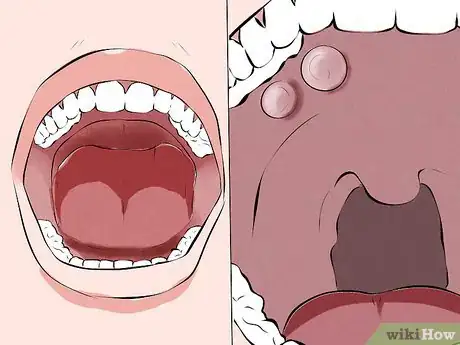



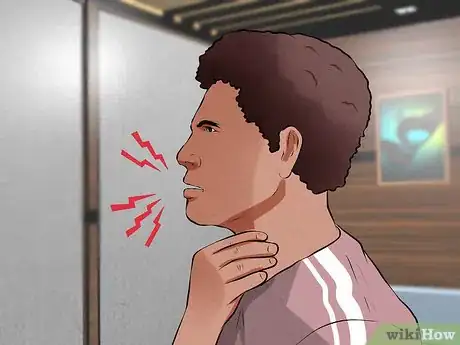
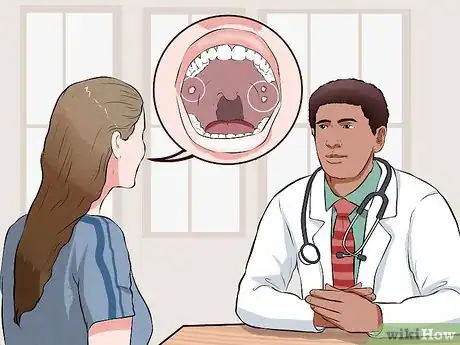

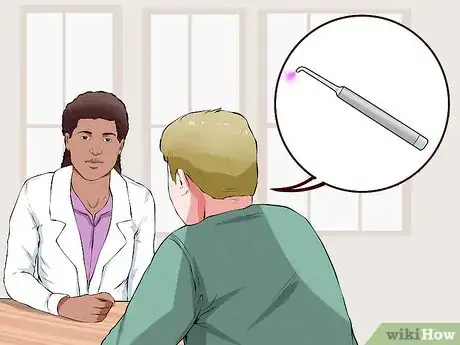
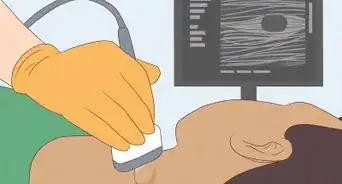




-Step-13.webp)

-Step-8-Version-3.webp)






















































Medical Disclaimer
The content of this article is not intended to be a substitute for professional medical advice, examination, diagnosis, or treatment. You should always contact your doctor or other qualified healthcare professional before starting, changing, or stopping any kind of health treatment.
Read More...